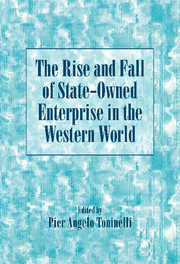Book contents
- Frontmatter
- Contents
- Preface
- Contributors
- PART I SETTING THE STAGE
- PART II NATIONAL CASES
- 5 The Rise and Fall of State-Owned Enterprise in Germany
- 6 Beyond State and Market: Italy's Futile Search for a Third Way
- 7 State Enterprise in Britain in the Twentieth Century
- 8 The Rise and Decline of State-Owned Industry in Twentieth-Century France
- 9 The Rise and Decline of Spanish State-Owned Firms
- 10 Fifty Years of State-Owned Industry in Austria, 1946–1996
- 11 A Reluctant State and Its Enterprises: State-Owned Enterprises in the Netherlands in the “Long” Twentieth Century
- 12 State-Owned Enterprises in a Hostile Environment: The U.S. Experience
- Conclusion: Schumpeter Revisited
- Index
5 - The Rise and Fall of State-Owned Enterprise in Germany
Published online by Cambridge University Press: 05 December 2011
- Frontmatter
- Contents
- Preface
- Contributors
- PART I SETTING THE STAGE
- PART II NATIONAL CASES
- 5 The Rise and Fall of State-Owned Enterprise in Germany
- 6 Beyond State and Market: Italy's Futile Search for a Third Way
- 7 State Enterprise in Britain in the Twentieth Century
- 8 The Rise and Decline of State-Owned Industry in Twentieth-Century France
- 9 The Rise and Decline of Spanish State-Owned Firms
- 10 Fifty Years of State-Owned Industry in Austria, 1946–1996
- 11 A Reluctant State and Its Enterprises: State-Owned Enterprises in the Netherlands in the “Long” Twentieth Century
- 12 State-Owned Enterprises in a Hostile Environment: The U.S. Experience
- Conclusion: Schumpeter Revisited
- Index
Summary
The history of state-owned enterprise (SOE) in Germany has to be written on three different levels. Since unification in 1871, Germany has been a decentralized federal state; thus state ownership occurred on the national, state (Länder), and municipal levels. For historical reasons, the states were very strong and independent when it came to regulation of industry and infrastructure. This independence was vigorously defended by the southern states, notably Bavaria, in view of what was often felt to be suffocating Prussian dominance in national affairs. Prussia held about two-thirds of German territory during the German Empire and the Weimar Republic. The economic and political center of both Prussia and Germany was Berlin, which often made it difficult to draw a line between national and state interests. Given its sheer size, Prussia, unlike the other states, always had the option of pursuing its plans on either the state or the national level. Whatever Prussia did, its policy had a national dimension. Prussia's SOE, therefore, must be compared with national enterprise elsewhere. SOE in the other German states, by contrast, often served the function of protecting what was left of sovereignty. On the level of the individual states, this latent antagonism was reproduced between state governments and municipalities, frequently making municipal enterprise a guarantor of local sovereignty. Thus, there was not one agent of state ownership in Germany but three, and it was not unusual for them to compete against each other.
- Type
- Chapter
- Information
- The Rise and Fall of State-Owned Enterprise in the Western World , pp. 103 - 127Publisher: Cambridge University PressPrint publication year: 2000
- 11
- Cited by

